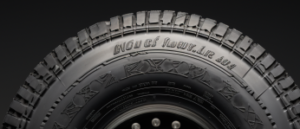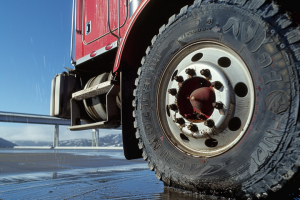Last Updated on May 13, 2024
Introduction to Tire Pressure Monitoring Systems in Trucks
Integrating advanced technologies like the Tire Pressure Monitoring System (TPMS) has become increasingly crucial for truck maintenance and safety. This article explores the basics of TPMS technology and underscores its role in enhancing truck safety and efficiency.
TPMS Technology
TPMS, an acronym for Tire Pressure Monitoring System, is an innovative technology designed to continuously monitor the air pressure inside pneumatic tires on various vehicles, including trucks. The system primarily alerts drivers about tire pressure issues, preventing possible failures that could lead to severe accidents.
Importance of TPMS for Truck Safety and Efficiency
The relevance of TPMS in trucks cannot be overstated, especially considering the following aspects:
- Enhanced Safety: Proper tire pressure is required to handle trucks safely. TPMS alerts drivers about under-inflated or over-inflated tires, leading to tire blowouts or decreased vehicle handling capabilities.
- Preventive Maintenance: By providing real-time data on tire condition, TPMS allows truck drivers and fleet managers to perform proactive maintenance, reducing the risk of tire-related breakdowns and accidents.
- Improved Fuel Efficiency: Correct tire pressure is essential for optimal fuel economy. Under-inflated tires increase rolling resistance, leading to higher fuel consumption. TPMS helps maintain the correct tire pressure, thus optimizing fuel usage.
- Extended Tire Life: Consistent and correct tire pressure reduces wear and tear, extending the lifespan of the tires. This saves costs in the long term and reduces the environmental impact through decreased tire disposal.
- Compliance with Regulations: In many regions, TPMS is not just a safety feature but a legal requirement for new vehicles, including trucks. Ensuring that TPMS functions correctly is vital for compliance with transportation and safety regulations.
TPMS in trucks is a critical component in the broader context of vehicle safety and efficiency. Its ability to provide timely alerts about tire pressure not only enhances the vehicle’s and its occupants’ safety but also contributes to the overall operational efficiency of truck fleets.
How TPMS Works in Trucks
Implementing Tire Pressure Monitoring Systems (TPMS) in trucks significantly advances vehicular safety and efficiency. This section provides a comprehensive overview of the TPMS components, the distinction between direct and indirect systems, and the interpretation of TPMS alerts.
Components of a TPMS
A typical TPMS in vehicles consists of several key components:
- Sensors: In a direct TPMS, sensors are located in each tire to measure the pressure accurately. These sensors can measure the air pressure and sometimes the temperature inside the tire.
- Transmitters: These are integrated with the sensors and are responsible for sending the pressure data wirelessly to the vehicle’s central monitoring system.
- Receiver: The vehicle has a receiver that collects sensor data and transmits it to the dashboard display.
- Display: This is the interface where the driver receives real-time information about the tire pressure, usually presented on the truck’s dashboard.
Direct vs. Indirect TPMS Systems
The two primary types of TPMS systems are direct and indirect, each with unique characteristics:
- Direct TPMS: This system uses pressure sensors in each tire. These sensors transmit pressure information to the vehicle’s computer system. Direct TPMS provides accurate, real-time data and can notify the driver about which specific tire is underinflated.
- Indirect TPMS: Rather than using physical pressure sensors in each tire, indirect TPMS works with the vehicle’s Antilock Braking System (ABS) to monitor tire rotation speeds and other factors to estimate pressure levels. If a tire’s pressure is low, it will rotate at a different rate than the other tires, triggering an alert.
Understanding TPMS Alerts
The TPMS alerts are critical for the driver to understand and act upon. Here’s what the alerts signify:
- Warning Light: The most common alert is a warning light on the dashboard, often represented by an exclamation mark inside a tire cross-section. This light indicates a pressure issue in one or more tires.
- Pressure Readouts: Some advanced TPMS setups provide detailed digital readouts of the pressure in each tire, allowing for precise monitoring.
- Temperature Warnings: Some systems also monitor tire temperature, which can provide early warnings of potential issues like overheating due to under-inflation.
- System Fault Indicator: A separate indicator or different behavior of the TPMS warning light might indicate a malfunction within the TPMS itself.
Understanding the components and functionalities of TPMS and the ability to interpret its alerts is essential for truck drivers and fleet operators. This knowledge not only contributes to safer driving conditions but also aids in the maintenance and longevity of the vehicle’s tires.
Types of Vehicles and TPMS Suitability
The versatility of Tire Pressure Monitoring Systems (TPMS) extends across various types of vehicles, especially trucks. Each truck category, from light-duty to heavy-duty and specialized trucks, has requirements and challenges regarding tire pressure monitoring. This section explores the suitability of TPMS for different truck categories and the customization required for specialized trucks.
TPMS for Different Truck Categories
Trucks are broadly categorized based on their size, capacity, and purpose. Each category has distinct TPMS needs:
- Light-duty trucks: They include pickup trucks and smaller hauliers often used for light commercial or personal purposes. A standard TPMS that monitors tire pressure and alerts the driver to significant deviations is usually sufficient for these vehicles. These systems are akin to those used in passenger vehicles, focusing on road safety and fuel efficiency.
- Medium-Duty Trucks: Medium-duty trucks, like box trucks and flatbeds used for local deliveries or construction purposes, require a more robust TPMS. Given their higher load capacity compared to light-duty trucks, the TPMS for these vehicles needs to account for varying load weights and the impact this has on tire pressure.
- Heavy-duty trucks include large freight trucks, 18-wheelers, and long-haul vehicles. TPMS for these trucks must be highly durable and capable of monitoring many tires. They often incorporate advanced features like temperature monitoring and real-time pressure updates to ensure safety over long distances and varying load conditions.
Customizing TPMS for Specialized Trucks
Specialized trucks, such as those used in construction, agriculture, or hazardous material transport, require custom TPMS solutions:
- Varied Pressure Settings: Specialized trucks often operate under diverse conditions requiring different tire pressure settings. Custom TPMS for these vehicles can include adjustable alert thresholds catering to varying operational needs.
- Durability in Harsh Conditions: Trucks used in construction or off-road conditions encounter rough terrain, requiring TPMS sensors and components that are rugged and resistant to damage.
- Advanced-Data Integration: Integrating TPMS data with other vehicular systems can enhance performance and safety for trucks with specific operational parameters. For example, trucks carrying sensitive or hazardous materials may need a TPMS that integrates with stability control systems.
- Specialized Sensor Technology: Some specialized trucks might need advanced sensors capable of handling high tire pressure ranges or providing more precise readings for critical applications.
The application of TPMS in the trucking industry is more than just a one-size-fits-all solution. It requires careful consideration of the specific needs and operational conditions of different truck categories and the unique demands of specialized trucks.
By tailoring TPMS technology to these diverse requirements, truck owners and operators can significantly enhance tire safety, vehicle performance, and overall efficiency.
The proper TPMS setup leads to safer roads, prolonged tire life, and potentially substantial savings in maintenance and fuel costs, making it an invaluable investment for the modern trucking fleet.
Benefits of TPMS for Truck Owners
Adopting Tire Pressure Monitoring Systems (TPMS) in trucks offers many benefits, significantly impacting road safety, fuel economy, tire lifespan, and the environment. This section highlights these advantages, emphasizing why TPMS is an invaluable addition to any truck.
Enhanced Road Safety
TPMS helps enhance road safety in the following ways:
- Prevention of Tire Blowouts: By monitoring tire pressure, TPMS helps prevent blowouts often caused by under-inflated tires. Blowouts can lead to loss of control, posing a significant risk, especially for trucks.
- Improved Handling and Braking: Properly inflated tires ensure better vehicle handling and effective braking, essential for large vehicles like trucks.
- Early Warning System: TPMS serves as an early warning system, alerting drivers about tire issues before they become hazardous, thereby allowing timely preventive measures.
Improved Fuel Economy
The impact of TPMS on fuel economy offers benefits like:
- Reduced Rolling Resistance: Correctly inflated tires have lower rolling resistance, so the engine doesn’t have to work as hard to move the truck, leading to better fuel efficiency.
- Cost Savings: Improved fuel economy translates into direct cost savings for truck owners, a crucial factor given the high operational costs of running a truck.
- Optimal Performance: Maintaining the recommended tire pressure ensures that the truck operates at its designed performance level, contributing to overall efficiency.
Extended Tire Lifespan
TPMS contributes to the longevity of tires in the following ways:
- Even Wear and Tear: Proper inflation helps distribute weight and stress on the tire, leading to even wear and a longer life.
- Prevention of Overinflation: Overinflated tires are as detrimental as underinflated ones. TPMS helps maintain the right balance, preventing unnecessary stress and wear on the tire fabric.
- Cost-Efficient: Extending tire life means fewer replacements and repairs, which saves truck owners money.
Environmental Advantages
Here are the environmental benefits of TPMS that are noteworthy:
- Reduced Carbon Footprint: Improved fuel efficiency reduces carbon emissions, contributing to ecological sustainability.
- Decreased Tire Waste: By extending tire life, TPMS indirectly reduces the number of tires in landfills.
- Energy Conservation: Lower fuel consumption also implies less demand for fossil fuel resources, thereby conserving energy.
Adopting TPMS in trucks offers comprehensive benefits, enhancing not just the safety and operational aspects for truck owners but also contributing positively to the environment. As such, TPMS is an essential tool in the modern trucking industry, aligning with safety, efficiency, and sustainability goals.
Cost-Benefit Analysis of TPMS for Truck Fleets
Incorporating Tire Pressure Monitoring Systems (TPMS) into truck fleets is an investment that requires a detailed understanding of its long-term financial implications. This analysis explores the long-term savings and Return on Investment (ROI) of TPMS for truck fleets and compares the costs associated with TPMS against traditional tire monitoring methods.
Long-Term Savings and ROI of TPMS
Although the adoption of TPMS in truck fleets is initially costly, it leads to significant savings over time and benefits like:
- Fuel Efficiency: According to TPMS, properly inflated tires can improve fuel efficiency. The U.S. Department of Energy notes that for every 1% drop in tire pressure, fuel consumption is a corresponding 0.3% rise. TPMS ensures tires are optimally inflated, leading to fuel savings and contributing to the ROI.
- Extended Tire Life: TPMS helps distribute tire wear evenly by maintaining proper inflation, which prolongs tire life. This reduction in wear and tear leads to fewer tire replacements and repairs, leading to considerable savings.
- Reduced Downtime: By preventing tire-related breakdowns and accidents, TPMS minimizes truck downtime. This saves immediate repair costs and avoids revenue loss due to operational disruptions.
- Safety and Compliance: Improved security reduces accidents and potential legal liabilities. Additionally, compliance with tire pressure regulations avoids penalties and fines, contributing to ROI.
Calculating the ROI involves assessing these savings against the initial and ongoing costs of the TPMS. Fleet operators often find that the savings in fuel, tire replacements, and reduced downtime significantly outweigh the investment in TPMS over time.
Cost Comparison: TPMS vs Traditional Tire Monitoring
Comparing TPMS with traditional tire monitoring methods highlights the cost-effectiveness of TPMS:
- Labor and Time: Traditional methods require manual checks, which are labor-intensive and time-consuming. TPMS automates this process, freeing up labor for other tasks and reducing the time spent on tire checks.
- Accuracy and Consistency: Manual checks are subject to human error and inconsistencies. TPMS provides accurate, consistent readings, leading to better tire maintenance and reduced risk of tire-related incidents, which can be costly.
- Predictive Maintenance: Unlike manual methods, TPMS can offer predictive insights, allowing for proactive maintenance. This predictive capability can prevent costly emergency repairs and replacements.
The ROI of TPMS becomes evident when the long-term savings are weighed against the costs associated with traditional tire monitoring methods. Integrating TPMS can provide substantial financial benefits and enhanced operational efficiency for fleet operators, making it a prudent choice in the long run.
Installing TPMS in Your Truck
Installing a Tire Pressure Monitoring System (TPMS) in your truck can help you keep track of your tire pressure and ensure that your vehicle is operating safely. This section focuses on selecting the appropriate TPMS for your car, the installation process, and essential maintenance and calibration tips.
Choosing the Right TPMS for Your Truck
Selecting a suitable TPMS requires consideration of several factors, including:
- Compatibility: Ensure the TPMS is compatible with your truck model. Compatibility affects the system’s effectiveness and reliability.
- Type of TPMS: Decide between a direct or indirect TPMS based on your needs. Natural systems are generally more accurate but may be more costly.
- Sensor Type: Consider the type of sensors used in the TPMS. Some sensors are designed for specific types of tires or wheel setups.
- Features: Look for additional features such as temperature readings, real-time pressure updates, and the ability to monitor multiple tires simultaneously.
- Brand and Quality: Opt for a reputable brand known for quality and reliability. This may cost more upfront but can save money in the long term due to fewer replacements and repairs.
Professional vs. DIY Installation
Deciding between professional and DIY Installation involves evaluating expertise, time, and cost:
- Professional Installation: It is recommended for those not mechanically inclined or lacking the necessary tools. Professionals can ensure a correct and safe installation, which is required for TPMS functionality.
- DIY Installation: For those with mechanical skills and the right tools, installing a TPMS can be a doable project. However, it requires a thorough understanding of the system and the vehicle’s tire and wheel assembly.
- Cost-Benefit Analysis: While DIY installation can save money, weigh this against the risk of incorrect Installation, which can lead to system failure or damage.
Maintenance and Calibration Tips
Regular maintenance and calibration are critical to the TPMS’s longevity and accuracy. Here are some tips that can help:
- Regular Checks: Periodically check the TPMS sensors for damage or battery life, especially if they are the type that requires battery replacement.
- Calibration: Ensure the TPMS is calibrated according to the manufacturer’s specifications. This may need to be done periodically or after tire changes or rotations.
- Professional Inspection: Have the TPMS checked during regular vehicle maintenance. Professionals can diagnose and rectify issues that might not be apparent to the average user.
- Firmware Updates: For advanced TPMS models, keep the system’s firmware updated to ensure it functions effectively and benefits from the latest technological advancements.
Installing and maintaining a TPMS in your truck demands careful consideration, from choosing the right system to ensuring proper Installation and maintenance. Investing in a TPMS, whether you choose professional services or a DIY approach, offers significant benefits in terms of road safety and operational cost savings.
Common TPMS Issues
While Tire Pressure Monitoring Systems (TPMS) help maintain tire health and ensure safety on the road, they are not immune to issues. Understanding common TPMS problems and how to address them is essential for truck owners. We will uncover how to decode TPMS warning signals, handle false alarms, and replace TPMS sensors.
Decoding TPMS Warning Signals
The TPMS warning light on your truck’s dashboard is the primary indicator of potential tire pressure issues. Here is how to interpret the warning signs correctly:
- Steady Illumination: A light that stays on typically indicates that one or more tires are significantly under-inflated. Checking and inflating the tire pressures to the recommended levels is crucial.
- Flashing Light: A flashing TPMS light often signals a malfunction within the TPMS itself. This could be due to a sensor failure, a communication issue between the sensor and the receiver, or a battery problem in the sensor.
- Temperature Warnings: Some advanced TPMS also include temperature warnings, which may indicate an overheated tire — often a sign of under-inflation or heavy load on the tire.
Handling False Alarms
Occasionally, TPMS can generate false alarms due to various reasons:
- Seasonal Temperature Changes: Sudden temperature drops can cause tire pressure to decrease temporarily, triggering the TPMS light. Once the tires warm up, the pressure might return to normal levels.
- Sensor Issues: Faulty or ageing sensors can send incorrect readings. Regular checks and maintenance can prevent these issues.
- Re-Calibration Needs: After tire rotation, replacement, or pressure adjustments, the TPMS may need to be reset or recalibrated to function accurately.
When encountering a potential false alarm, it’s advisable to manually check the tire pressures with a reliable gauge before taking further action.
Replacing TPMS Sensors
Sensor replacement is an essential aspect of TPMS maintenance. Here are some tips to help with the replacement:
- Lifespan of Sensors: TPMS sensors have a limited lifespan, often dictated by the battery life, ranging from 5 to 10 years. Once the battery dies, the entire sensor typically needs replacing.
- Compatibility: Ensure the new sensors are compatible with your truck’s TPMS system. Using the right type can lead to system errors or accurate readings.
- Professional Installation Recommended: Given the technical nature and the need for precise calibration, professionals should replace TPMS sensors.
- Post-Installation Calibration: After installing new sensors, they must be calibrated to ensure accurate readings. This process can vary depending on the truck model and the TPMS type.
Navigating TPMS Vendors and Suppliers
For truck fleet operators, selecting the right Tire Pressure Monitoring System (TPMS) vendor is as important as implementing TPMS. This process involves evaluating various providers and their products to ensure they meet the specific needs of your fleet.
Choosing the Right TPMS Provider
Selecting a TPMS provider is a decision that will have long-term implications for your fleet’s operation, safety, and efficiency. Here’s how to approach this selection:
- Industry Reputation and Experience: Look for vendors with a strong reputation and a track record of reliability in the TPMS market. Providers with extensive experience in the trucking industry are more likely to understand the unique challenges and requirements of truck fleets.
- Product Range and Compatibility: Ensure the vendor offers a range of TPMS products compatible with various types of trucks and tire configurations. A provider with a broad product range can cater to the diverse needs of a multi-type fleet.
- Technology and Innovation: Assess the technological advancement of the TPMS offered. Vendors who invest in the latest technologies and innovations can provide more efficient, accurate, and user-friendly systems.
- Customer Support and Service: Reliable customer support is vital. Choose a vendor who offers robust after-sales support, training, and service. This support is crucial for troubleshooting, maintenance, and ensuring the longevity of your TPMS.
- Cost-Effectiveness: While cost should not be the only determining factor, it is essential to consider the pricing of the TPMS concerning the features and benefits it offers. A cost-effective solution that meets your needs without compromising quality or functionality is ideal.
Criteria for Selecting TPMS Products and Services
When evaluating TPMS products and services, consider the following criteria:
- Accuracy and Reliability: The primary function of TPMS is to provide accurate and reliable tire pressure readings. Assess the systems’ precision and reliability over time and under various conditions.
- Ease of Installation and Use: A user-friendly TPMS, both in terms of Installation and daily operation, can significantly reduce training time and operational complexity.
- Scalability and Flexibility: The TPMS should be scalable and flexible to accommodate the growth of your fleet or changes in your operational needs.
- Integration Capabilities: Consider how well the TPMS integrates with other systems in your trucks, such as telematics or fleet management software. Integration can enhance operational efficiency and data analysis.
- Durability and Maintenance Needs: TPMS used in trucks must be durable to withstand harsh operating conditions. Additionally, evaluate the maintenance requirements of the system and the ease with which any repairs or replacements can be made.
- Regulatory Compliance: Ensure the TPMS meets your region or country’s relevant regulatory requirements and standards.
Carefully navigating the selection of TPMS vendors and their products is essential for optimizing the benefits of this technology for your truck fleet. The right TPMS provider is a supplier and a long-term partner in your fleet’s journey toward improved security and performance.
Legal Requirements and Compliance
For truck owners and operators, understanding and adhering to the legal requirements surrounding Tire Pressure Monitoring Systems (TPMS) is not just a matter of vehicle maintenance but of compliance with regulatory standards.
TPMS Regulations for Trucks
The regulations regarding TPMS in trucks vary depending on the country and the specific type of vehicle:
- Mandatory in Many Countries: In several regions, such as the European Union and the United States, TPMS is compulsory for all new vehicles, including trucks, as part of road safety regulations. This regulation is primarily to reduce road accidents caused by under-inflated tires.
- Specific Requirements: Regulations may specify the type of TPMS required (direct or indirect), the accuracy of the readings, and the pressure range within which the system must alert the driver.
- Periodic Inspections: In many jurisdictions, TPMS is inspected as part of regular vehicle safety checks. Failure to have a functioning TPMS can result in fines or other penalties.
- Retrofitting Requirements: While new trucks are often equipped with TPMS, older models might require retrofitting to comply with current regulations.
Ensuring Compliance with Transportation Standards
To ensure compliance with transportation standards, truck owners and operators should:
- Stay Informed: Keep abreast of the latest TPMS regulations in your region. This information can often be found on government transportation websites or through industry associations.
- Regular System Checks: Perform routine maintenance on the TPMS to ensure it functions correctly. This includes checking sensor batteries, system calibration, and overall system functionality.
- Professional Assistance: Consider seeking professional assistance for TPMS installation, maintenance, and inspection. This ensures compliance with the technical aspects of the regulations.
- Record Keeping: Maintain records of TPMS checks, maintenance, and repairs. This documentation can be essential during vehicle inspections or in the case of compliance audits.
- Educate Drivers: Ensure drivers are educated about TPMS, including how to read alerts and the importance of tire pressure in vehicle safety and efficiency.
Conclusion & Recommendations
As we conclude our comprehensive guide on Tire Pressure Monitoring Systems (TPMS) for trucks, it’s important to recap TPMS benefits and provide recommendations for further reading and educational resources. The integration of TPMS in your truck fleet not only promotes safety and efficiency but also aligns with environmental and legal standards.
Recap of TPMS Benefits
TPMS technology is pivotal in enhancing road safety by reducing the risk of tire blowouts and improving vehicle handling and braking efficiency. These systems are instrumental in maintaining optimal tire pressure, contributing to extended tire lifespan and improved fuel economy. Furthermore, TPMS helps truck owners and operators comply with various transportation regulations, ensuring their vehicles meet safety standards.
The environmental impact of TPMS must be addressed, too. TPMS systems contribute to lower carbon emissions and decrease tire waste by facilitating better fuel economy and reducing tire wear. These factors are crucial in today’s environmentally conscious society, where sustainability is critical in all business operations, including transportation and logistics.
Discover the Ideal Truck Tire Selection at Tires Easy Truck
As part of your ongoing commitment to vehicle safety and efficiency, consider exploring the range of tire options available at Tires Easy Truck. Our selection is tailored to meet the diverse needs of truck owners and operators, ensuring you find the perfect match for your vehicle’s requirements. Whether you’re looking for tires that offer durability for long hauls or provide maximum efficiency for urban transportation, Tires Easy Truck has you covered.
We invite you to visit our website, Tires Easy Truck, to explore our extensive range of high-quality truck tires. Our easy-to-navigate platform ensures you can easily find and purchase the right tires for your fleet. So, take the next step in enhancing your truck’s performance and safety – choose Tires Easy Truck for all your tire needs.
With the right tires and a robust TPMS, you set a standard for safety, efficiency, and compliance in your trucking operations. Remember, investing in quality tires and TPMS is investing in the future of your fleet.
FAQs
How do I choose the right TPMS for my truck?
Selecting the right TPMS for your truck involves assessing Compatibility with your model, considering the type (direct or indirect), and understanding each system’s specific features. Prioritize systems renowned for accuracy and durability and ensure they meet your truck’s needs.
What does “TPMS service required” mean for trucks?
For trucks, “TPMS service required” usually indicates the need for system maintenance or repair. This may involve recalibrating the system, addressing sensor issues, or replacing depleted batteries.
What services need to be performed for a truck’s TPMS?
Critical services for a truck’s TPMS include calibration, routine maintenance, sensor battery replacement, and repairs for any system malfunctions. Regular checks are vital for ensuring system accuracy and longevity.
What are the TPMS rules for trucks?
TPMS rules for trucks often include requirements for system functionality, timely alerts for pressure deviations, and adherence to specific safety standards. Regulations vary by region, so it’s important to know local laws.
What is the difference between a TPMS vendor and a provider for trucks?
A TPMS truck vendor usually refers to a company selling TPMS products, while a provider may offer comprehensive services, including Installation, maintenance, ongoing support, and sales.
How do I know what tire pressure sensor to buy for my truck?
When choosing a tire pressure sensor for your truck, ensure it’s compatible with your vehicle’s make and model, and consider factors like sensor technology, reliability, and resistance to harsh trucking environments.
Can any TPMS sensor be used on any truck?
No, TPMS sensors are not universally compatible with all trucks. They must match the specific requirements of the truck’s TPMS system for accurate functioning and safety compliance.
How is TPMS calculated?
For trucks, TPMS sensors typically measure tire pressure directly using internal sensors or indirectly by analyzing wheel speed and rotation data. The system then alerts the driver if the pressure falls outside the preset safe range.











